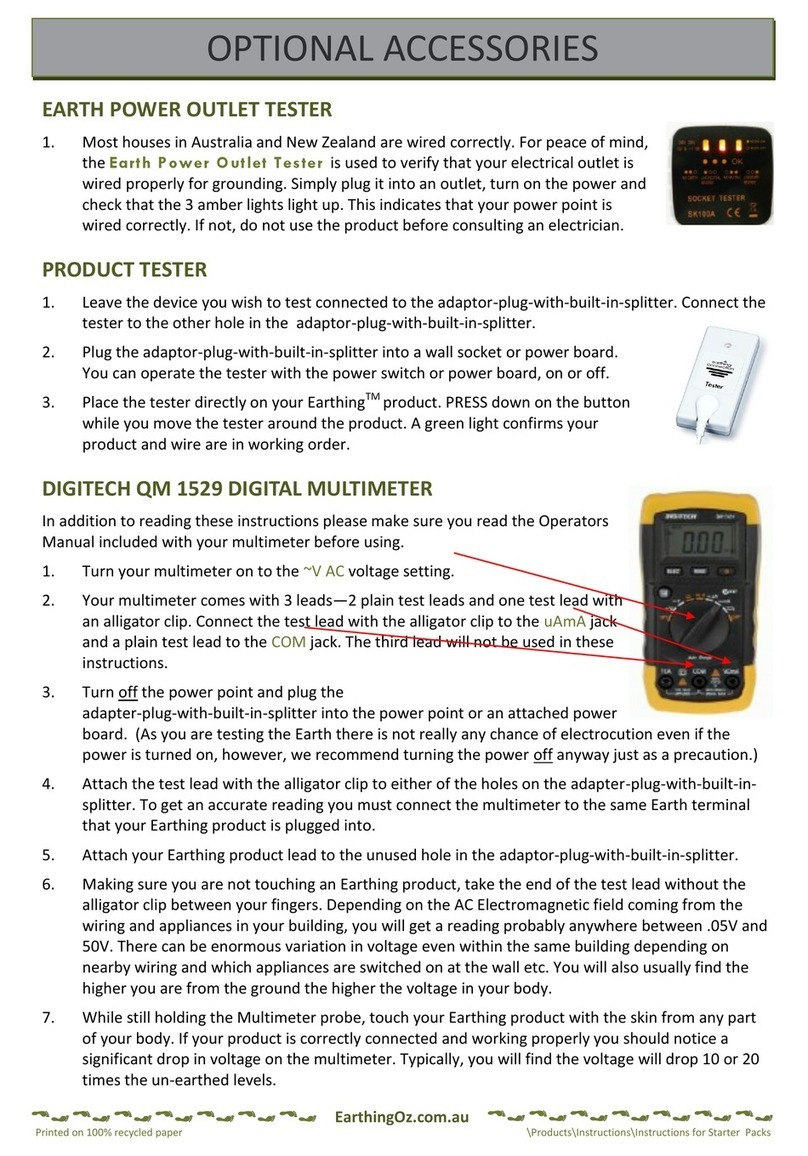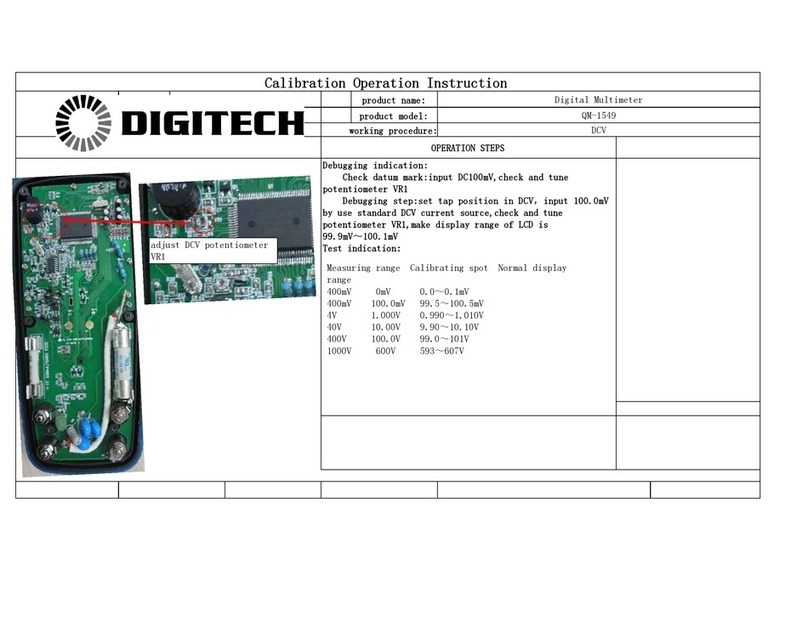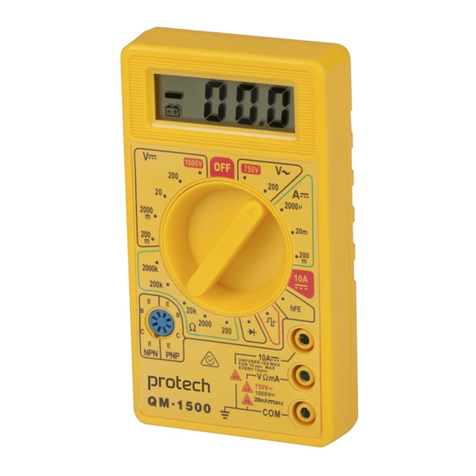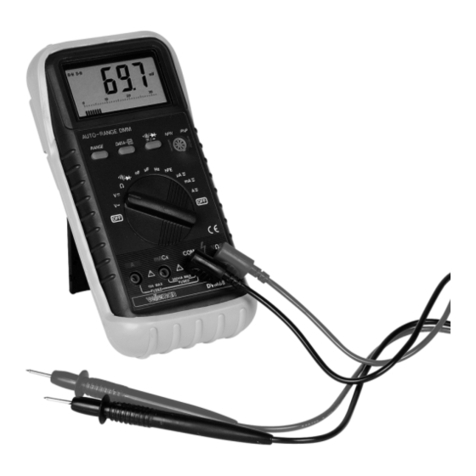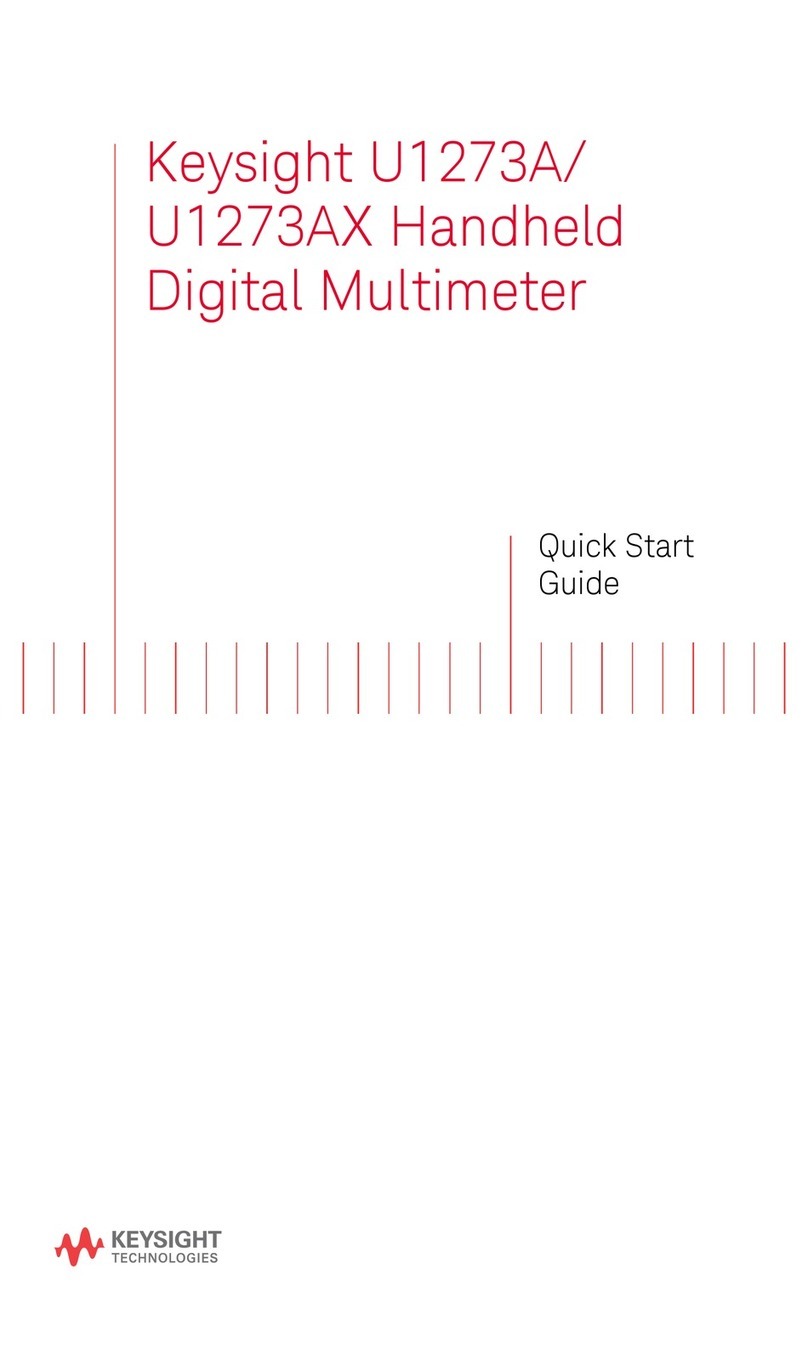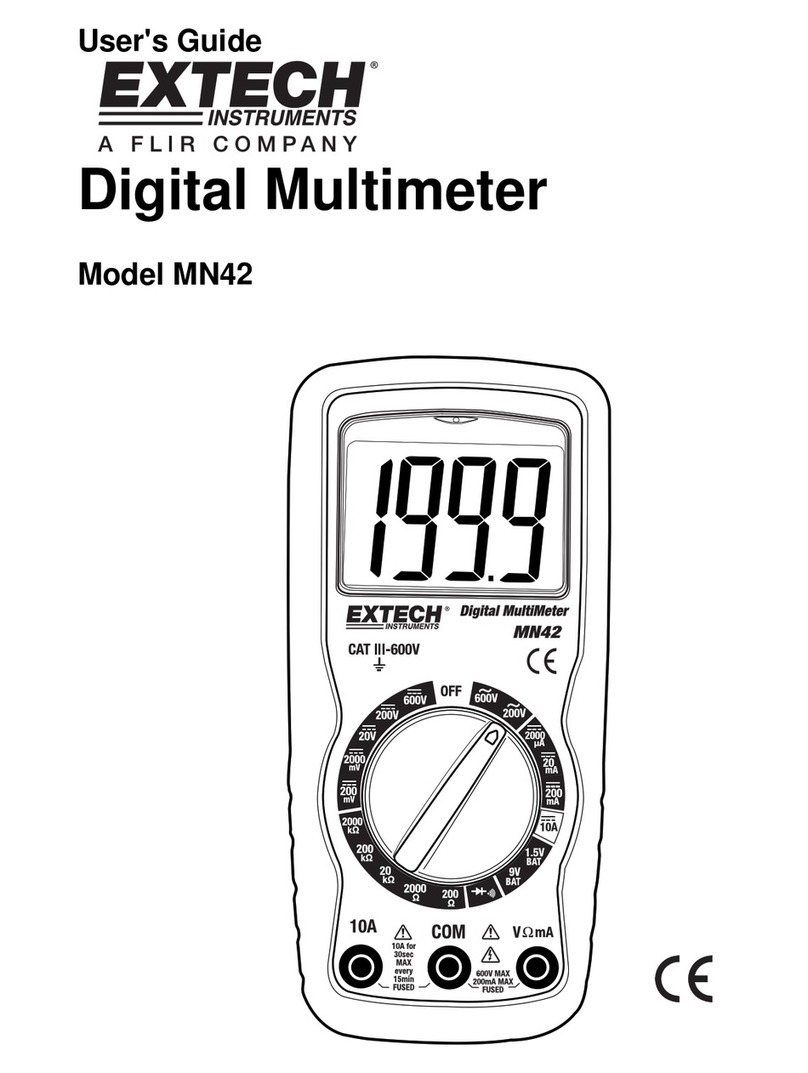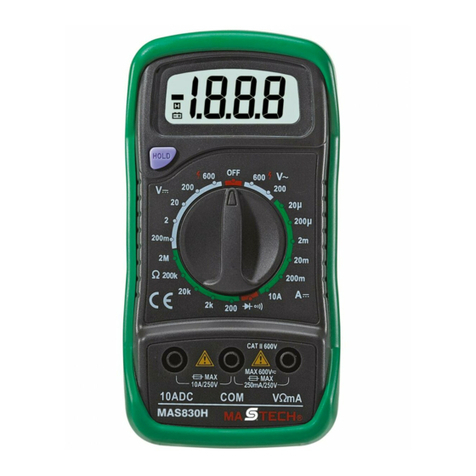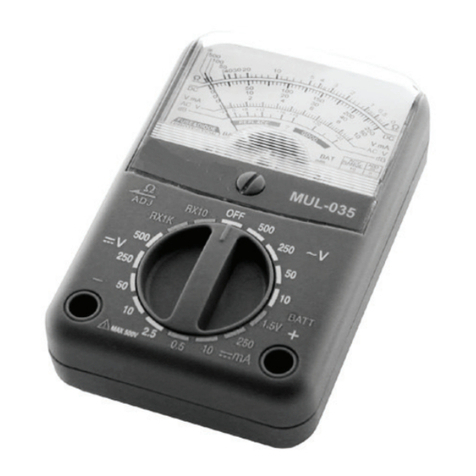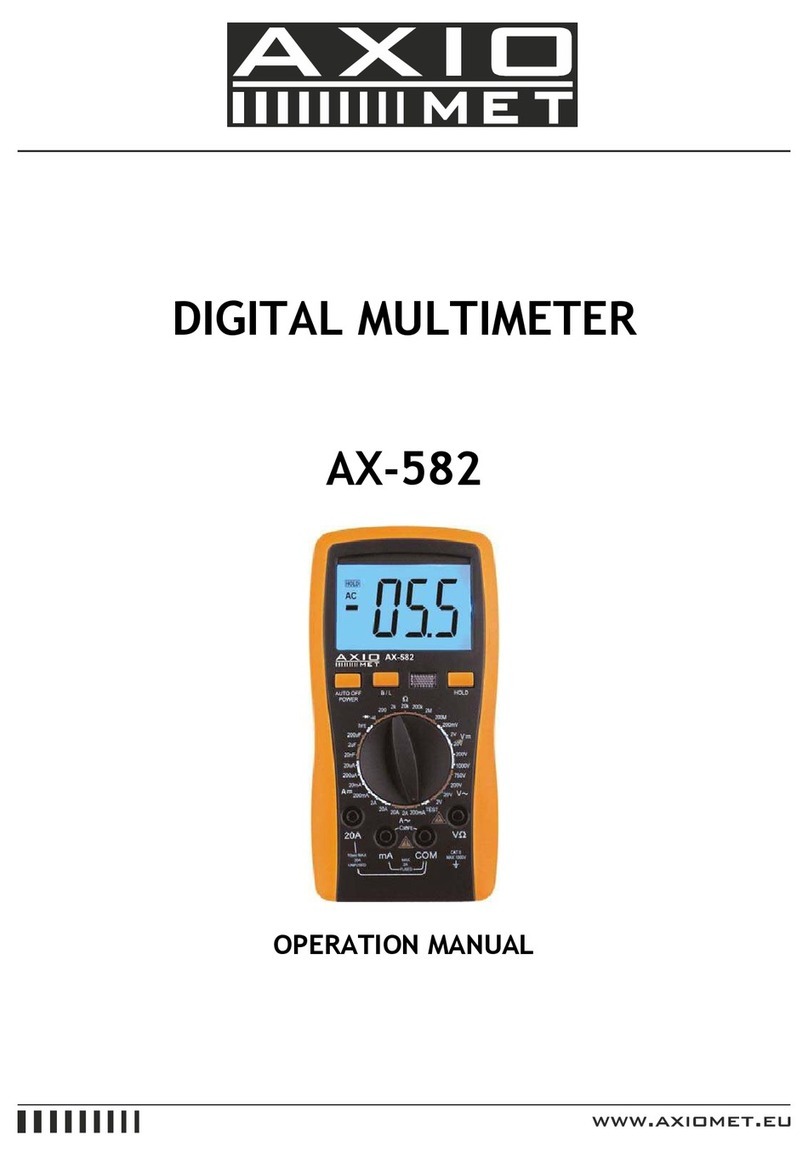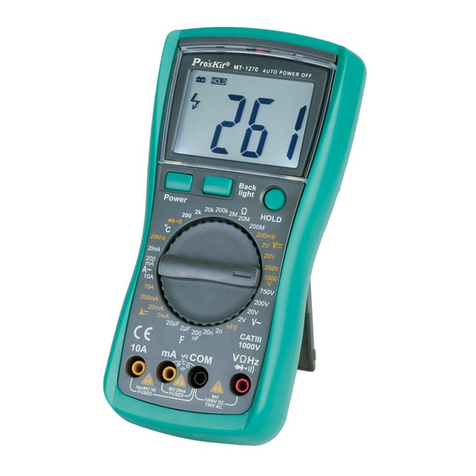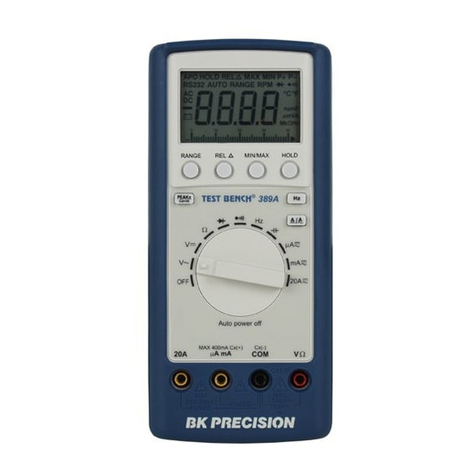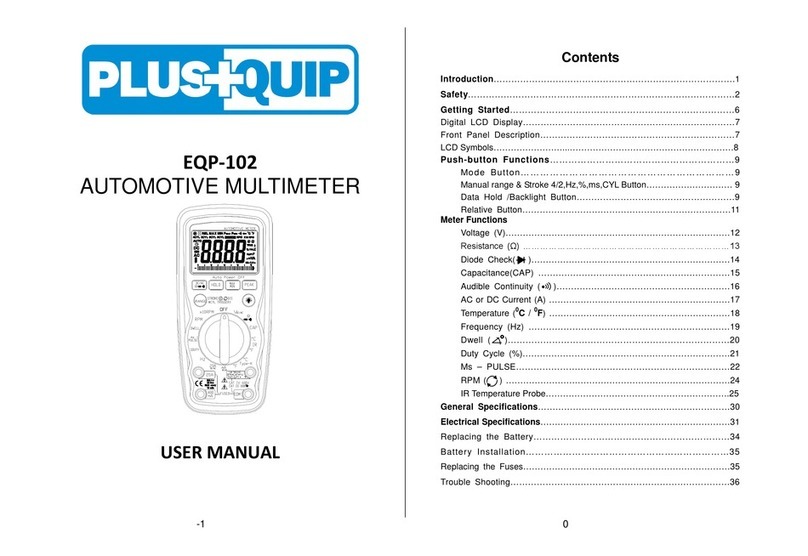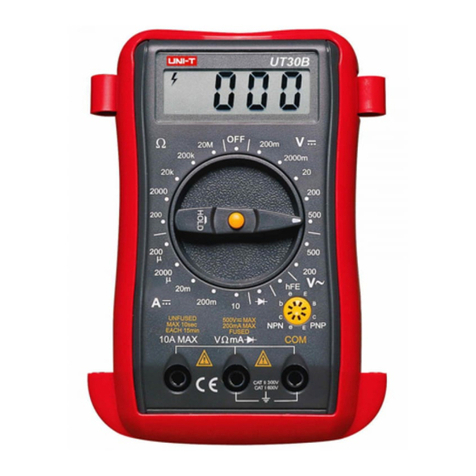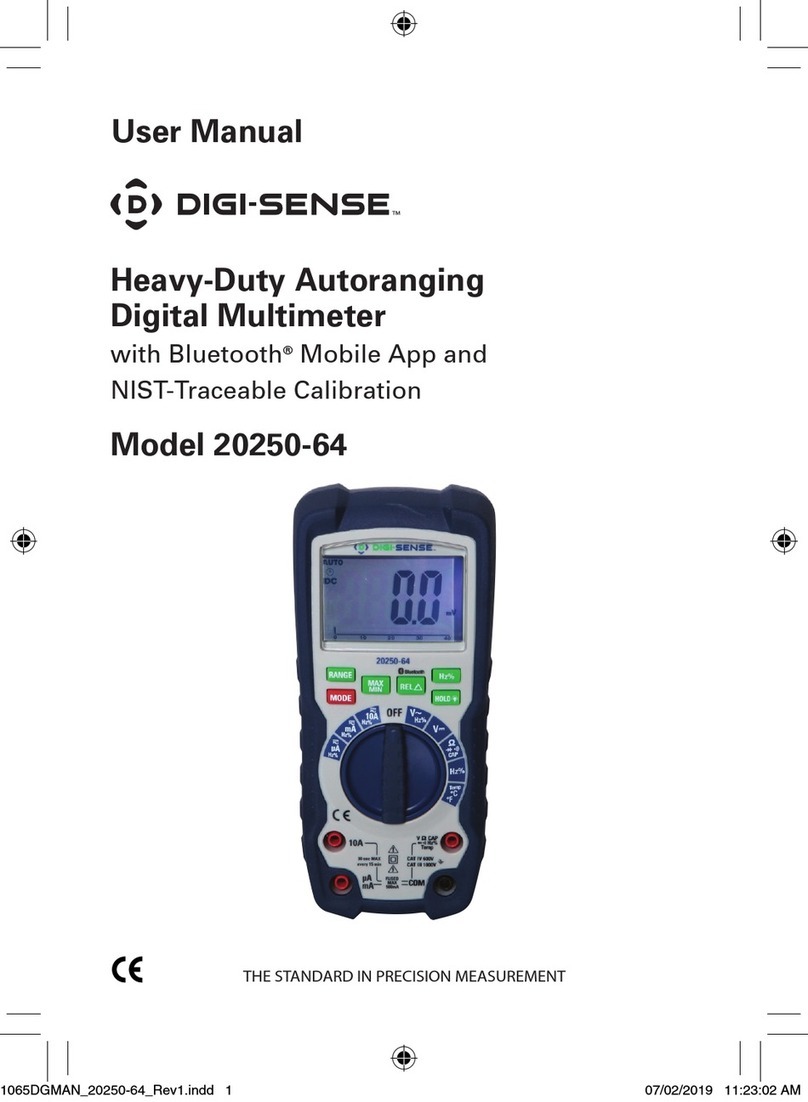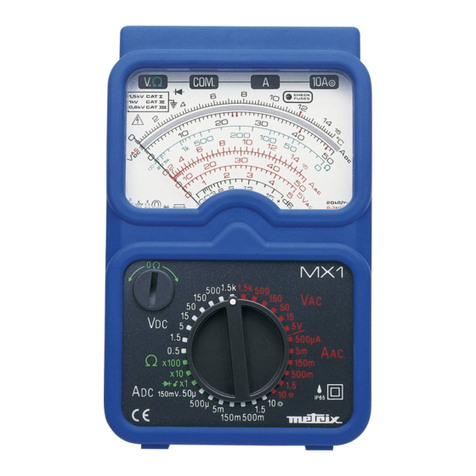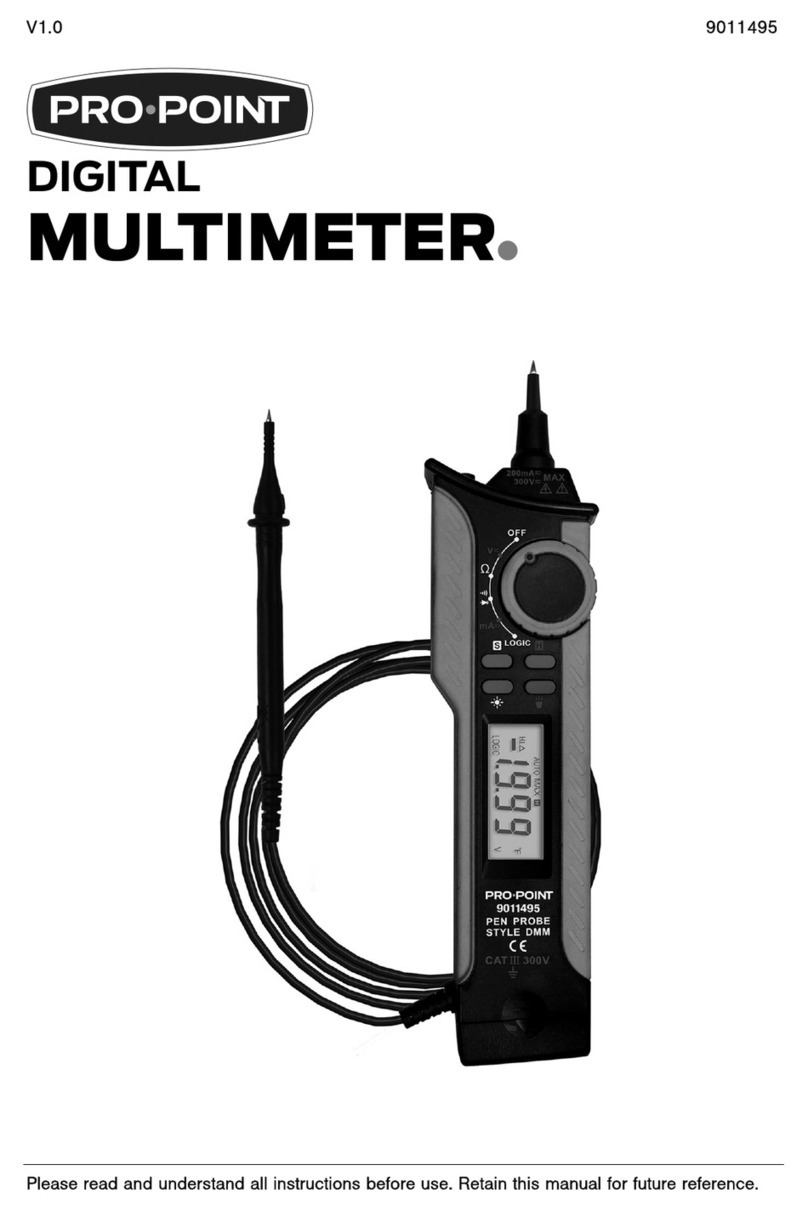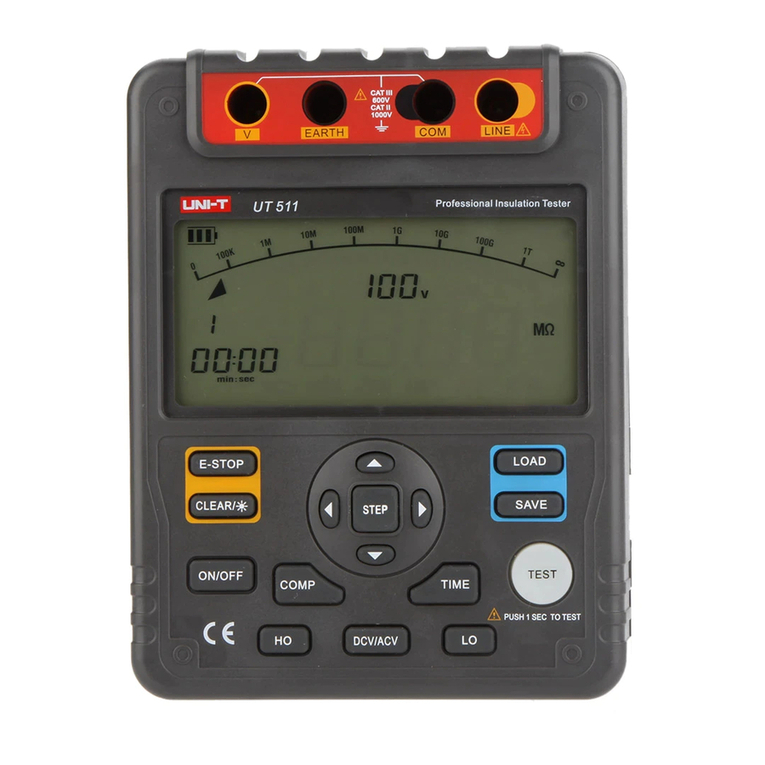digi-tech QM-1552 User manual

True RMS Inductance
/Capacitance
Digital Multimeter User Manual
QM-1552
SPECIALIST

True RMS Inductance
/Capacitance
Digital Multimeter User Manual
QM-1552
Thank you for purchasing this Digital Multimeter. A powerful true RMS
multimeter that includes non-contact voltage testing, and a backlit LCD.
Please familiarise yourself with the functions of the multimeter before use.
We recommend retaining this manual for ease of reference.
• Do not use the meter if the meter or test leads look damaged, or if you
suspect that the meter is not operating properly.
• Never ground yourself when taking electrical measurements. Do not touch
exposed metal pipes, outlets, xtures, etc., which might be at ground
potential.
• Keep your body isolated from ground by using dry clothing, rubber shoes,
rubber mats, or any approved insulating material.
• Turn off power to the circuit under test before cutting, de-soldering, or
breaking the circuit. Small amounts of current can be dangerous.
• Use caution when working above 60V DC or 30V AC rms, such voltages
pose a shock hazard.
• When using the probes, keep your ngers behind the nger guards on the
probes.
• Measuring voltage which exceeds the limits of the multimeter may
damage the meter and expose the operator to a shock hazard. Always
recognize the meter voltage limits as stated on the front of the meter.
• Never apply voltage or current to the meter that exceeds the specied
maximum.

FUNCTIONS
Max. Display 2000 Counts
Basic Accuracy 0.5%
DC Voltage Range 200mV-1000V
AC Voltage Range 200mV-750V
DC Current Range 200µA-10A
AC Current Range 200µA-10A
Resistance(Ω) 200Ω>200MΩ
Capacitance (CAP) 10nF-100mF
Frequency (Hz) 10Hz-10MHz
Inductance 2mH-20H
Temperature -20°C - 1000°C
Data Hold Yes
Diode Test Yes
Duty Cycle Yes
Continuity Check Yes
NCV (Non-Contact Voltage
Detection)
Yes
Line Test Yes
Max/Min Yes
Hz/% Yes
Range Manual
LCD Backlight Yes
Auto Power Off Yes
Auto Power Off Disable Yes

SAFETY
This symbol indicates that the operator must refer to an explanation
in the Operating Instructions to avoid personal injury or damage to the
meter.
CAUTIONS
• Improper use of this meter can cause damage, shock, injury or death.
Read and understand this user manual before operating the meter.
• Always remove the test leads before replacing the battery o fuses.
• Inspect the condition of the test leads and the meter itself for any
damage before operating the meter.
• Do not measure voltage if the voltage on the terminals exceeds 1000V
above earth ground.
• Use great care when making measurements if the voltages are greater
30VAC RMS or 60VDC, these voltages are considered a shock hazard.
• Always discharge capacitors and remove power from the device to be
tested before performing Diode, Resistance or Continuity tests.
• To avoid damages to the meter, do not exceed the maximum limits of
the input values shown in the specications.
• If the multimeter is going to be unused for an extended period of time,
remove the batteries to prevent them from draining.

LED Indicator
LCD Display
Rotary
Switch
Function
Buttons
Input Jacks

FUNCTIONS
LCD Screen Readings and measurements taken by the multimeter
will display in this area.
Function
Buttons
HOLD: Press this button to lock the readings in the LCD,
press again to exit the hold mode.
Press “ ” to switch the back light mode, around 15
second exit from back light mode.
Rotary Switch Moving the rotary switch to each individual range of
measurement or to the range needing to be measured
will also power on the unit.
Input Jacks V/Ω: The positive input terminal for voltage, resistance,
diode, temperature, frequency, capacitance, etc.
COM: the negative input terminal for voltage, diode,
temperature, etc.
mA: the input terminal for lower 200mA current
A: 10A input terminal.
Functions FUNC: Activates secondary functions where available -
primarily for use with diode or continuity testing
REL: Stores reading and resets display to zero. Sets a
relative reference point to measure against the next
reading.
MIN/MAX: Stores input values; beeps when a value is
breached and a new value is set.

SYMBOL DESCRIPTION
HOLD Data Hold
Diode Test
mV
V
Unit of Voltage
Hz
KHz
MHz
Unit of Frequency
Ω
KΩ
MΩ
Unit of Resistance
hFE Transistor
TRMS True RMS Measurement
%Duty Cycle Measurement
Low Voltage Indication
Continuity Check
uA
mA
A
Unit of Current
pF
nF
uF
mF
Unit of Capacitance
uH
mH
H
Unit of Inductance
°C Centigrade Temperature
°F Fahrenheit Temperature
REL Relative Value Measurement

GENERAL SPECIFCATIONS
Max. Input Voltage: AC750VRMS, DC1000V
Sampling Rate: Approx. 2 times/sec
Operating Temperature: 0°C-40°C (32°F~104°F)
Operating Humidity: <80%RH
Storage Temperature: -10°C-60°C (14°F~122°F)
Storage Humidity: <70%RH
Power Supply: 9V Battery (6F22) x 1pc
Dimension: 200 x 92 x 60mm (L x W x H)
Weight: Approx. 230g (include battery)
BOX CONTENTS
1 x Digital Multimeter
1 x Temperature Probe
1 x User Manual
MEASUREMENT SPECIFICATIONS
Accuracy: ±(%readings + digit),
Environment temperature: 18°C~28°C; humidity: ≤80%

RANGE RESOLUTION ACCURACY
200mV 0.1mV ±(0.5% reading + 3 digits)
2V 0.001V
±(0.8% reading + 3 digits)20V 0.01V
200V 0.1V
1000V 1V ±(1.0% reading + 5 digits)
RANGE RESOLUTION ACCURACY
200mV 0.1mV
±(1.0% reading + 5 digits)
2V 0.001V
20V 0.01V
200V 0.1V
750V 1V ±(1.2% reading + 5 digits)
RANGE RESOLUTION ACCURACY
200µA 0.1µA
±(1.0% reading + 5 digits)
2mA 0.001mA
20mA 0.01mA
200mA 0.1mA
2A 0.001A
10A 0.01A ±(1.5% reading + 10 digits)
DC VOLTAGE
AC VOLTAGE
DC CURRENT
Input Impedence: 10MΩ
Max. Input Voltage: 1000VDC
Input Impedence: 10MΩ
Max. Input Voltage: 750V ACRMS
Frequency Range: 40-1000Hz
Overload Protection: Fuse FF200mA/500V for mA range
Fuse FF10A/500V for A range

RANGE RESOLUTION ACCURACY
200µA 0.1µA ±(1.2% reading + 5 digits)
2mA 0.001mA
±(1.5% reading + 5 digits)20mA 0.01mA
200mA 0.1mA
2A 0.001A ±(1.8% reading + 15 digits)
10A 0.01mA
RANGE RESOLUTION ACCURACY
200Ω0.1Ω
±(0.8% reading + 5 digits)
2kΩ0.001kΩ
20kΩ0.01kΩ
200kΩ0.1kΩ
2MΩ0.001MkΩ
20MΩ0.01MΩ±(1.0% reading + 10 digits)
200MΩ0.1MkΩ± {(5.0% +10d) -10d}
RANGE FUNCTON
Display approximate forward voltage of diode.
Built-in buzzer will sound if resistance is less than
100Ω.
AC CURRENT
RESISTANCE
DIODE & CONTINUITY
Overload Protection: Fuse FF200mA/500V for mA range
Fuse FF10A/500V for A range
Frequency Range: 40-1000Hz
Overload Protection: 250VDC or 250VAC RMS

RANGE RESOLUTION ACCURACY
10Hz 0.01Hz
±(0.1% reading + 2 digits)
100Hz 0.1Hz
1kHz 0.001kHz
10kHz 0.01kHz
100kHz 0.1kHz
1MHz 0.001MHz
10MHz 0.01MHz
RANGE RESOLUTION ACCURACY
-20° ~ 400° 1°C ±(2.0% reading + 3 digits)
400° ~ 1000°
0° ~ 752° 1°F ±(3.0% reading + 3 digits)
752° ~ 1832°
TEMPERATURE
FREQUENCY
Overload Protection: 250VDC or 250VAC RMS
Overload Protection: 250VDC or 250VAC RMS

RANGE RESOLUTION ACCURACY
10nF 0.001nF ±(4.0% reading + 25 digits)
100nF 0.01nF
±(4.0% reading + 25 digits)
1µF 0.001µF
10µF 0.01µF
100µF 0.1µF
1mF 1µF
±(5.0% reading + 25 digits)10mF 10µF
100mF 100µF
RANGE RESOLUTION ACCURACY
2mH 0.001mH ±(3.0% reading + 15 digits)
20mH 0.01mH
200mH 0.1mH ±(3.5% reading + 15 digits)
2H 0.001H ±(3.5% reading + 20 digits)
20H 0.01H
CAPACITANCE
INDUCTANCE
Overload Protection: 250VDC or 250VAC RMS
NOTE: It is normal for small capacitance measurements to display a
reading once removed from the component being measured. Deduct the
reading from the reading shown when measuring the capacitance for an
accurate measurement.
OPERATING INSTRUCTIONS
AC AND DC VOLTAGE MEASUREMENT
WARNING:
Risk of electrocution. High-voltage circuits, both AC and DC, are very
dangerous and should be measured with great care.
Overload Protection: 360VDC or AC RMS

• To avoid electrical shock and/or damage to the instrument, do not
attempt to take any voltage measurement that might exceed 1000VDC
or 750VAC RMS.
• To avoid electrical shock and/or damage to the instrument, do not apply
more than 1000VDC or 750VAC RMS between the common terminal and
the earth ground.
1. Set the rotary switch to the voltage position.
2. Insert the black test lead banana plug into the negative COM jack;
insert the red test lead banana plug into the positive V/Ωjack.
3. Touch the black test probe tip to the negative side of the circuit; touch
the red test probe tip to the positive side of circuit.
4. Read the voltage in the LCD display. The polarity of the red test lead
connection will be indicated when making DC Voltage measurement
eg. a reverse polarity reading will show as negative on the display.
NOTE: Unstable display may occur, especially at the low voltage range
measurement, even no test leads inset at input terminals, if an erroneous
reading is suspected, short the Vjack and COM jack and make sure the
zero displayed at LCD.
CURRENT MEASUREMENT
WARNING:
• To avoid damage to the meter, check the internal fuse before measuring
current.
• Use the proper terminals, function and range for any current
measurement
• Never attempt an open circuit potential to earth that is greater than
250V.
• Do not place the test leads in parallel with a circuit or component when
the test leads are plugged into the current terminals.
1. Remove the power from the circuit you are testing and discharge the
capacitors of the circuit prior to setting the rotary switch to measure
current.
2. Insert black test lead banana plug into the negative COM jack. For
current measurement less than 200mA, insert the red test lead banana
plug into the mA jack. For current measurement between 200mA to
10A insert the red test lead banana plug into 10A jack.
3. Place the red test lead on the anode of the diode and the black test
lead on the cathode of diode. The meter will show the approximate
forward voltage of diode while reverse voltage will indicate OL.
4. Touch the test probe tips to the circuit or wire you wish to check, and
the maximum value of resistance will be shown in the display. If the
resistance is less than 100Ω, the audible signal will sound.

NOTE:
• In a circuit, a good diode should produce a forward bias reading of
voltage, however, the reverse-bias reading can be variable based on
resistance of other pathways between the probe tips.
• To avoid electric shock, never measure continuity on circuits of wires
with voltage.
RESISTANCE MEASUREMENT
WARNING:
To avoid electric shock, disconnect power to the unit under test and
discharge all capacitors before taking any resistance measurements.
Remove the batteries and unplug the line cords.
1. Set the rotary switch to the desired resistance range.
2. Insert the black test lead banana plug into the negative COM jack,
insert the red test lead banana plug into the positive V jack.
3. Touch the test probe tips across the circuit or part under test. It is best
to disconnect one side of the part under test so the rest of the circuit
will not interfere with the resistance reading.
4. Read the resistance in the LCD display.
NOTE:
• The measured value of a resistor in a circuit usually is different from the
rated value of resistor, it is because the test current of the meter ows
through all possible paths between the probe tips.
• In order to ensure the best accuracy in measurement of low resistance,
short the test leads before the measurement and subtract this resistance
value of the test leads.
• For high resistance measurement, the meter may take a few seconds to
stabilize.
• In the open circuit, the meter display OL to indicate the over range.
CAPACITANCE MEASUREMENT
WARNING:
To avoid electric shock, disconnect power to the unit under test and
discharge all capacitors before taking any capacitance measurements.
1. Set the rotary switch to desired capacitance range.
2. Insert the black test lead banana plug into the negative COM jack,
insert the red test lead banana plug into the positive mA CX jack.
3. Touch the test leads to the capacitor to be tested and read the
capacitance value in the display.

NOTE:
• The test may take more time for large capacitors to charge, wait until
the readings settle before removing the leads.
• To improve the accuracy of measurement less than 10nF, subtract the
residual capacitance of the meter and test leads.
TEMPERATURE MEASUREMENT
WARNING:
To avoid electrical shock, do not perform temperature measurement when
the input voltage exceeds 36VDC or 36VAC RMS.
1. Set the rotary switch to °C / °F position, LCD displays values of
environmental temperature.
2. Insert the temperature probe into the input jack, insert red plug of
thermo probe into V °C/°F jack, black plug of thermo probe into COM
jack, making sure to observe the correct polarity.
3. Place the temperature probe head onto the part you wish to measure,
keeping the probe touching the surface until the reading stabilises.
4. Read the temperature in the LCD display.
FREQUENCY MEASUREMENT
WARNING:
To avoid electric shock, do not apply more than 250VDC or 250VAC RMS
before taking frequency measurement.
1. Set the rotary switch to desired frequency range.
2. Insert the black text lead banana plug into the negative COM jack and
the red test lead banana plug into the positive Hz jack.
3. Touch the test lead tips to the circuit under test.
4. Read the frequency value in the LCD display.
INDUCTANCE MEASUREMENT
1. Set the rotary switch to desired inductance range.
2. Insert the black test lead banana plug into the negative COM jack and
the red test lead banana plug into the positive ma LX jack.
3. Touch the test lead tips to the circuit under test.
4. Read the inductance value in the LCD display.
DISPLAY BACKLIGHT
Press the button for 1 or 2 seconds to turn on or off the display
backlight function, the backlight will automatically turn off after 10
seconds.

HOLD FUNCTION
The hold function freezes the reading in the display, press the HOLD
button momentarily to activate or to exit the hold function.
AUTO POWER OFF
The auto off feature will turn the meter off after 15 minutes.
LOW BATTERY INDICATION
The icon will appear in the LCD display when the battery voltage
becomes low, replace the battery when this icon appears.
MAINTENANCE
WARNING:
• To avoid the electric shock, disconnect the test leads from any source of
voltage before removing the back cover or the battery or fuse covers.
• To avoid electric shock, do not operate the meter until the battery and
fuse covers are in place and fastened securely.
BATTERY INSTALLATION
To avoid the false readings, replace the battery as soon as the battery
indicator appears.
1. Turn power off and disconnect the test leads from the meter.
2. Open the rear battery cover by using screwdriver.
3. Insert the battery into battery holder, observing the correct polarity.
4. Put the battery cover back in place, secure with the screws.
REPLACING THE FUSES
1. Turn power off and disconnect the test leads from the meter.
2. Remove the battery cover and the battery.
3. Remove the screws securing the rear cover.
4. Gently remove the old fuse and install the new fuse into fuse holder.
5. Replace and secure the rear cover, battery and battery cover.
Distributed by:
TechBrands by
Electus Distribution Pty. Ltd.
320 Victoria Rd, Rydalmere
NSW 2116 Australia
Ph: 1300 738 555
Int’l: +61 2 8832 3200
Fax: 1300 738 500
www.techbrands.com
Table of contents
Other digi-tech Multimeter manuals
